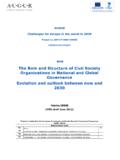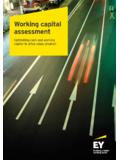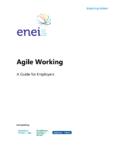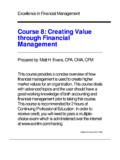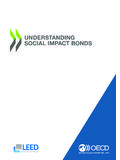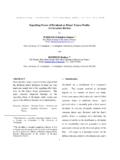Transcription of The impact of capital flows on the South African …
1 The impact of capital flows on the South African economic growth path since the end of apartheid Seeraj Mohamed Introduction This paper will consider international capital flows into and out of South Africa during the post-apartheid era. It will examine the types of flows that have been entering the country and how they were absorbed into the economy. It will consider the effects of these capital flows on the economy taking into account the broad range of literature that links financial crises to volatile surges in capital flows . It will also examine how capital flows have influenced South Africa s economic growth path since the end of apartheid. The post-apartheid government has a policy of gradual liberalisation of exchange controls. They have significantly eased the ability of South African residents to withdraw capital from the economy. Non-residents are allowed virtually free movement of capital into and out of the economy.
2 Current policies allow more and more South African capital to leave the country. The government hopes that a large share of the capital required for domestic investment, employment creation and development of the economy will come from foreigners. Within this approach, the government s policies on capital controls do not adequately differentiate between long-term foreign direct investments and short-term capital flows . Instead, senior government officials have argued that liberalisation of financial markets will lead to the deepening of financial markets. Even if this policy leads to more inflows of capital , will it lead to more and better investment? Seeraj Mohamed 1 This paper provides an assessment of the impact of capital flows on the South African economy over the past few decades. In so doing it contributes to international financial literature on South Africa because it is one of very few papers that examines the absorption of capital flows into the economy.
3 It also extends the South African literature because it uses heterodox analyses of financial crises to examine volatility and instability caused by capital flows in the South African economy. Furthermore, it is one of very few economics papers on South African that links the country s economic growth path to financial liberalisation and the type of financial flows crossing the country s border. Figure 1: Total net financial flows as % of GDP Source: Calculated using South African Reserve Bank (SARB) online historical data The end of apartheid and the relatively peaceful transition to democracy, combined with the introduction of financial market liberalisation in 1995, led to large increases in the amount of capital inflows into South Africa. Figure 1 shows net capital flows as percentages of GDP from 1980 to 2010. This paper examines the effects of more Seeraj Mohamed 2 domestic liquidity as a result of the large net capital inflows and argues that surges in inflows are of concern because they increase potential for financial risk and instability in the economy.
4 This aspect of the paper draws heavily from the analysis of financial crises in Palma (2003) who argues a Kindlebergian proposition that the effects of massive surges in inflows on domestic liquidity are key to understanding financial crises. Many countries experienced financial crises since the Each of these countries had very different methods in which they absorbed the large increases in capital inflows. Palma convincingly shows that large capital inflows are the key to explaining financial crises in all these countries despite their different absorption methods. Foreign direct investment is an important element of the South African government s economic policy. They seem to believe that their chances of attracting foreign direct investment will improve if they show investors that they are committed to maintaining orthodox macroeconomic fundamentals and other elements of the Washington Consensus.
5 These attitudes have not changed since the 2008 to 2010 global financial crisis, even though former bastions of orthodox economic policies and advocates of financial liberalisation, such as the IMF and OECD, now admit that the destabilising role of uncontrolled, cross-border financial flows and concede that regulations to control flows may be justified in certain 1 Mexico, South Korea, Thailand, Indonesia, the Philippines, Malaysia, Russia, Brazil, Turkey, Argentina and Uruguay have been plagued by financial crises since the mid-1990s. 2 See for example, the 2010 working paper of the IMF capital inflows: The role of controls by Ostry, Ghosh, Habermeier, Mahvash, Qureshi & Reinhard, and the OECD s 2011 economic Outlook, Chapter 6: Getting the most out of international capital flows . Seeraj Mohamed 3 Notwithstanding the changing perspectives of proponents of economic orthodoxy, the South African Government does not seem overly concerned with the disruptive effects that capital flows can have on a country s financial system and economy.
6 This lack of concern exists despite numerous financial crises in developing countries since the mid-1990s, South Africa s debt crisis in the mid-1980s and the South African currency crisis in 2001. Even the estimated loss of more than 1 million jobs as a result of the 2008 to 2010 global financial crisis has not deterred the Government from continuing its programme to further liberalise exchange The South African government has chosen to forsake controls over cross-border flows and instead to follow yet again the advice of orthodox economists and institutions such as the IMF to implement prudential regulation of finance and financial flows . Most of the capital flows entering South Africa have been short-term portfolio flows . The bulk of these flows has been absorbed by the private sector. There has been an accompanying surge in private sector access to credit. The private sector has not utilised their improved access to credit for productive investment.
7 Instead, easier access to credit has supported existing negative trends in the economy. For example, the exuberance in the stock market experienced from the early-1990s that led to higher share prices seems to have continued and to have been supported by easier private sector access to credit. The same applies to growth of imports and household consumption. In addition, capital flows are positively correlated with large-scale capital flight from the South African 3 The loss of around 1 million jobs during the crisis was referred to by Finance Minister Pravin Gordhan in his preface to the 2011 document of the South African National Treasury called A safer financial sector to serve South Africa better . The estimate is drawn for Statistics South Africa s Quarterly Employment Survey data. Seeraj Mohamed 4 economy. Therefore, the surge in capital inflows was not associated with economic activity that would lead to long-term growth in the economy.
8 Instead, one may associate the surge in net capital flows with increasing exuberance that leads to higher share price indices, more imports, growth in private consumption and high levels of capital flight. The reversal of net capital inflows such as those after the 1997 Asian Financial Crisis, the 2001 Dotcom crash, and the most recent global financial crisis shows significant negative impacts on South Africa s economic performance. The macroeconomic and financial instability associated with large movements of cross-border capital flows have weakened the economy over time. The liberalisation of cross border financial flows and the effect of the type of capital flows that entered the economy had a marked impact on the types of investment and the formation of capital stock in the economy since 1994. Therefore, the Government has not been able to achieve their stated economic goals to increase economic development, reduce unemployment and tackle the legacy of high inequality.
9 Instead, the growth path of the economy has led it away from sustainable economic development, has been unable to even dent high unemployment and caused inequality to increase. Papers by Ashman et al (2010) and myself (Mohamed, 2010) have described the changes associated with financial liberalisation and deregulation of cross border capital flows in South Africa as part of the financialisation of the South African 4 Mohamed (2010) and Ashman, Fine and Newman (2010) discuss financialisation of the South African economy. Note that Mohamed, Ashman and Newman were staff of the Corporate Strategy and Industrial Development Research Programme at the University of the Witwatersrand in 2010. Most (or more accurately almost all), of the recent literature on financialisation of the South African economy has come from CSID researchers). Seeraj Mohamed 5 REVIEW OF RECENT LITERATURE ON CAUSES AND CURES FOR FINANCIAL CRISES The South African literature on capital flows and potential risks of financial crisis is very thin so most of this literature review refers to literature dealing with global trends in capital flows and financial crises.
10 The South African government, which seems to be the major client for work on South Africa s position in international financial markets, continues to adhere to neoliberal solutions which imply that their thinking on financial crises is in line with mainstream neoliberal thinking. This may be a reason for the paucity of South African economic literature on this important subject. The government and SARB have accepted the mainstream argument that financial liberalisation is good for the economy. As a result, the government is pushing ahead with plans to further liberalise controls over the movement of capital by South African residents, despite their tacit acknowledgement that there has been large capital flight in the form of a foreign exchange amnesty. According to Bruce-Brand (2002) the post-apartheid government from 1994 planned with reintegration of SA into the global economy. A relatively cautious approach to the liberalisation of international financial flows was planned but clear signals were sent to global financial markets that the government s intention was to liberalise.
